Learninsta presents the core concepts of Biology with high-quality research papers and topical review articles.
Fruits – Structure of Fruits and its Types
We know about several kinds of fruits, but by botanical study we will be surprised to know the types of fruits and how they are produced by plants. Fruits are the products of pollination and fertilization, usually containing seeds inside.
In common person’s perspective a fruit may be defined as an edible product of the entire gynoecium and any floral part which is sweet, juicy or fleshy, coloured, aromatic and enclosing seeds. However the fruit is a fertilized and ripened ovary. The branch of horticulture that deals with the study of fruits and their cultivation is called pomology.
Structure of Fruit
Fruit has a fruit wall. It is otherwise called pericarp. It is differentiated into outer epicarp, middle mesocarp and inner endocarp. The inner part of the fruit is occupied by the seed.
Types of Fruit
Fruits are classified into three types:
Simple Fruits
The fruits are derived from a single ovary of a flower Example: Mango, Tomato. Simple fruits are classified based on the nature of pericarp as follows.
A. Fleshy Fruit
The fruits are derived from single pistil where the pericarp is fleshy, succulent and diffrentiated into epicarp, mesocarp and endocarp. It is subdivided into the following.
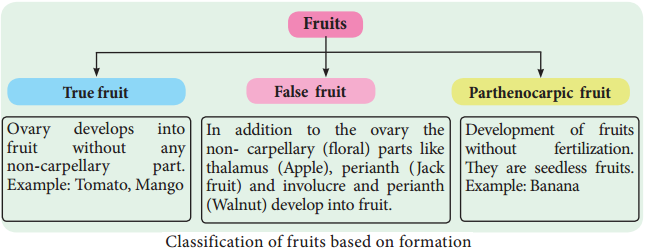
(a) Berry:
Fruit develops from bicarpellary or multicarpellary, syncarpous ovary. Here the epicarp is thin, the mesocarp and endocarp remain undifferentiated. They form a pulp in which the seeds are embedded. Example: Tomato, Grapes, Brinjal.
(b) Drupe:
Fruit develops from monocarpellary, superior ovary. It is usually one seeded. Pericarp is differentiated into outer skinny epicarp, fleshy and pulpy mesocarp and hard and stony endocarp around the seed. Example: Mango, Coconut.
(c) Pepo:
Fruit develops from tricarpellary inferior ovary. Pericarp turns leathery or woody which encloses, fleshy mesocarp and smooth endocarp. Example: Cucumber, Watermelon, Bottle gourd, Pumpkin.
(d) Hesperidium:
Fruit develops from multicarpellary, multilocular, syncarpous, superior ovary. The fruit wall is differentiated into leathery epicarp with oil glands, a middle firous mesocarp. The endocarp forms distinct chambers, containing juicy hairs. Example: Orange, Lemon.
(e) Pome:
It develops from multicarpellary, syncarpous, inferior ovary. The receptacle also develops along with the ovary and becomes fleshy, enclosing the true fruit. In pome the epicarp is thin skin like and endocarp is cartilagenous. Example: Apple, Pear.
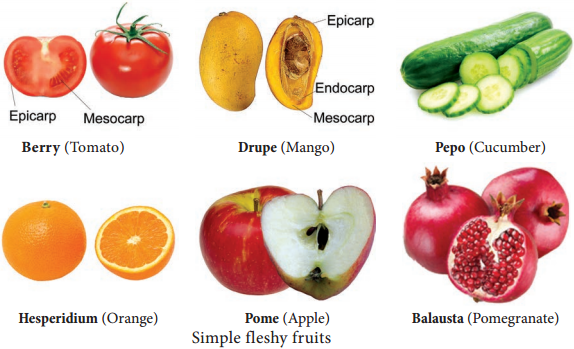
(f) Balausta:
A fleshy indehiscent fruit developing from multicarpellary, multilocular inferior ovary whose pericarp is tough and leathery. Seeds are attached irregularly with testa being the edible portion. Example: Pomegranate.
B. Dry Fruit
They develop from single ovary where the pericarp is dry and not differentiated into epicarp, mesocarp and endocarp. It is further subdivided into three types.
1. Dry Dehiscent Fruit
Pericarp is dry and splits open along the sutures to liberate seeds. They can be classified into following types.
(a) Follicle:
Fruit develops from monocarpellary, superior ovary and dehisces along one suture. Example: Calotropis.
(b) Legume or Pod:
Fruit develops from monocarpellary, superior ovary and dehisces through both dorsal and ventral sutures. Example: Pisum.
(c) Siliqua:
Fruit develops from bicarpellary, syncarpous, superior ovary initially one chambered but subsequently becomes two chambered due to the formation of false septum (replum). The fruit dehisces along two suture. Example: Brassica.
(d) Silicula:
Fruit similar to siliqua but shorter and broader. Example: Capsella.
(e) Capsule:
Fruit develops from multicarpellary, syncarpous, superior ovary. Based on the dehiscence pattern they are divided into.
(i) Septicidal:
Capsule splitting along septa and valves remaining attached to septa. Example: Aristolochia.
(ii) Loculicidal:
Capsule splitting along locules and valves remaining attached to septa. Example: Abelmoschus.
(iii) Poricidal:
Dehiscence through terminal pores. Example: Papaver.
2. Dry Indehiscent Fruit
Dry fruit which does not split open at maturity. It is subdivided into.
(a) Achene:
Single seeded dry fruit developing from single carpel with superior ovary. Achenes commonly develop from apocarpous pistil, Fruit wall is free from seed coat. Example: Clematis, Delphinium.
(b) Cypsela:
Single seeded dry fruit, develops from bicarpellary, syncarpous, inferior ovary with reduced scales, hairy or feathery calyx lobes. Example: Tridax.
(c) Caryopsis:
It is a one seeded fruit which develops from a monocarpellary, superior ovary. Pericarp is inseparably fused with seed. Example: Oryza.
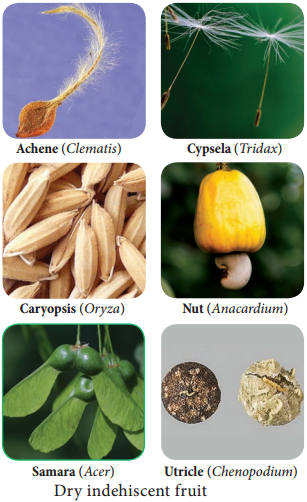
(d) Nut:
They develop from mulicarpellary, syncarpous, superior ovary with hard, woody or bony pericap. It is a one seeded fruit. Example: Anacardium.
(e) Samara:
A dry indehiscent, one seeded fruit in which the pericarp devlops into thin winged structure around the fruit. Example: Acer.
(f) Utricle:
They develop from bicarpellary, unilocular, syncarpus, superior ovary with pericarp loosely enclosing the seeds. Example: Chenopodium.
3. Schizocarpic Fruit
This fruit type is intermediate between dehiscent and indehiscent fruit. The fruit instead of dehiscing, splits into number of segments, each containing one or more seeds. They are of following types.
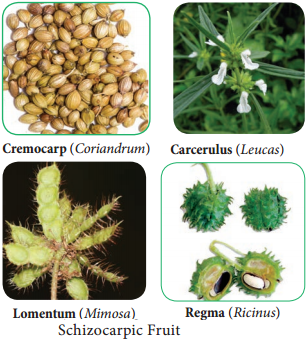
(a) Cremocarp:
Fruit develops from bicarpellary, syncarpous, inferior ovary and splitting into two one seeded segments known as mericarps. Example: Coriander.
(b) Carcerulus:
Fruit develops from bicarpellary, syncarpous, superior ovary and splitting into four one seeded segments known as nutlets. Example: Leucas.
(c) Lomentum:
The fruit is derived from monocarpellary, unilocular ovary. A leguminous fruit, constricted between the seeds to form a number of one seeded compartments that separate at maturity. Example: Mimosa.
(d) Regma:
They develop from tricarpellary, syncarpous, superior, trilocular ovary and splits into oneseeded cocci which remain attached to carpophore. Example: Ricinus.
Aggregate Fruits
Aggregate fruits develop from a single flower having an apocarpous pistil each of the free carpel develops into a simple fruitlet. A collection of simple fruitlets makes an Aggregate fruit. An individual ovary develops into a drupe, achene, follicle or berry. An aggregate of these fruits borne by a single flower is known as an etaerio. Example: Annona, Polyalthia.
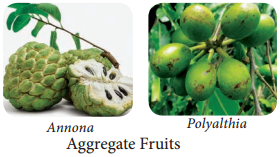
Multiple or Composite Fruit:
A Multiple or composite fruit develops from the whole inflorescence along with its peduncle on which they are borne.
(a) Sorosis:
A fleshy multiple fruit which develops from a spike or spadix. The flowers fused together by their succulent perianth and at the same time the axis bearing them become fleshy or juicy and the whole inflorescence forms a compact mass. Example: Pine apple, Jack fruit.
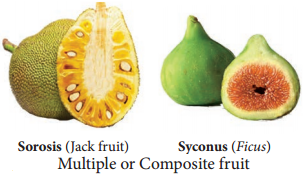
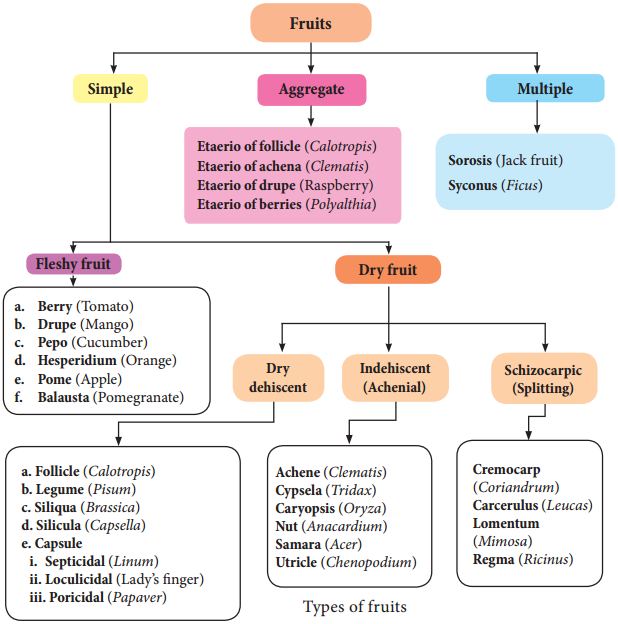
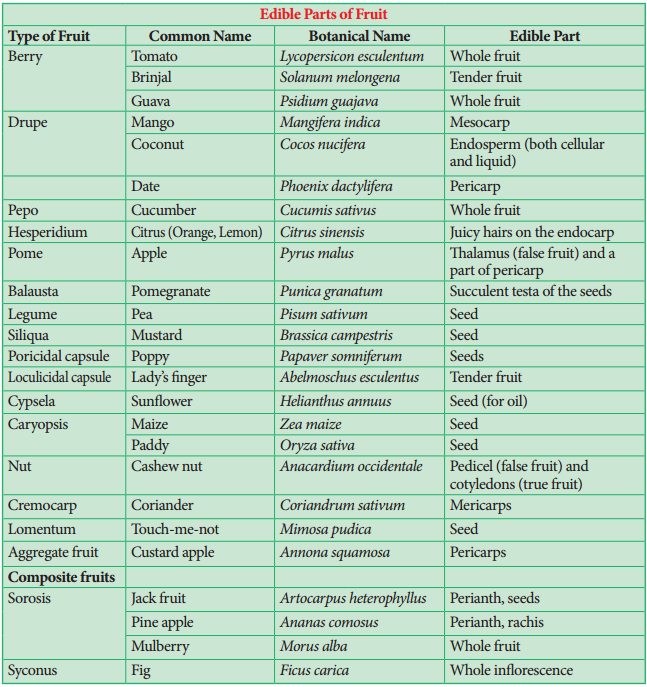
(b) Syconus:
A multiple fruit which develops from hypanthodium inflorescence. The receptacle develops further and converts into fleshy fruit which encloses a number of true fruit or achenes which develops from female flower of hypanthodium inflorescence. Example: Ficus
Functions of Fruit
- Edible part of the fruit is a source of food and gives energy for animals.
- They are source of many chemicals like sugar, pectin, organic acids, vitamins and minerals.
- The fruit protects the seeds from unfavourable climatic conditions and animals.
- Both fleshy and dry fruits help in the dispersal of seeds to distant places.
- In certain cases, fruit may provide nutrition to the developing seedling.
- Fruits provide source of medicine to human.